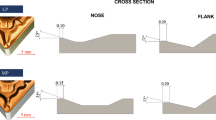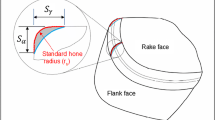Abstract
Short duration turning tests were performed with uncoated and various PVD-coated straight grade carbide inserts against AISI 1045 steel, without coolant. Cutting forces, built-up edge (BUE) intensity, and characteristics of the chips (length, curl diameter, and colour) were made and related to measurements of friction coefficient obtained from a custom heavy-load, high-temperature tribometer as well as from reported thermal conductivity values obtained from the literature. At lower cutting speeds, where the size of BUE tends to be larger, it is proposed that reductions in cutting forces and BUE intensity observed for certain PVD-coated inserts pertain more to reduced sticking intensity between tool and chip, for which the friction coefficient results from the tribometer are a helpful guide. At higher cutting speeds, hotter temperatures and greater thermal softening of work material at the tool-chip interface seem to be responsible for reductions in cutting force and BUE size, which is linked to the thermal conductivity of the coatings. As well, delamination of certain coatings was observed both during cutting tests as well as tribometer tests, suggesting the potential merit of the tribometer as a method for screening coatings for adequate substrate-adhesion. Investigations of tool wear during longer duration turning tests suggest that tribometer COF results can be predictive of relative tool wear rates among tool candidates, under cutting conditions that give rise to attrition as the dominant wear mechanism.
Similar content being viewed by others
References
Ramaswami R (1971) The effect of the built-up edge (bue) on the wear of cutting tools. Wear 18(1):1–10
Boyd JM, Hosseinkhani K, Velduis SC, Ng E (2016) Improved prediction of cutting forces via finte element simulations using novel heavy-load, high-temperature tribometer friction data. Int J Adv Manuf Technol 15:1–9
"EMT 100," [Online]. Available: http://www.extramet.net/emt-100-specs. [Accessed 2 December 2015].
Friedman MY, Lenz E (1970) Investigation of the tool-chip contact length in metal cutting. International Journal of Machine Tool Design and Research 10:401–416
Friedman MY, Lenz E (1973) The effect of thermal conductivity of tool material on cutting forces and crater wear rate. Wear 25:39–44
Bandyopadhyay BP (1984) Mechanisms of formation of built-up edge. Precis Eng 6(3):148–151
Martan J, Benes P (2012) Thermal properties of cutting tool coatings at high temperatures. Thermochim Acta 539:51–55
Jawahir IS, van Lutterwelt CA (1993) Recent developments in chip control: research and applications. CIRP Ann 45(1):659–693
Venkatesh VC, Zhou DQ, Xue W, Quinto DT (1993) A study of chip surface characteristics during the machining of steel. Annals of the CIRP 42:631–636
Ning Y, Rahman M, Wong YS (2001) Investigation of chip formation in high speed end milling. J Mater Process Technol 113:360–367
McAdam DJ Jr, Geil GW (1939) Rate of oxidation of steels as determined from interference colors of oxide films. Journal of Research of the National Bureau Standards 23:63–124
Lim SC, Lee SH, Liu YB, Seah KHW (1996) Wear maps for some uncoated cutting tools. Tribotest 3(1):67–88
Kramer BM, Judd PK (1985) Computational design of wear coatings. J Vac Sci Technol 3(6):2439–2444
Author information
Authors and Affiliations
Corresponding authors
Rights and permissions
About this article
Cite this article
Boyd, J.M., Veldhuis, S.C. Manifestations of reduced tool-chip friction during turning of AISI 1045 steel with PVD-coated carbide inserts. Int J Adv Manuf Technol 91, 687–698 (2017). https://doi.org/10.1007/s00170-016-9775-x
Received:
Accepted:
Published:
Issue Date:
DOI: https://doi.org/10.1007/s00170-016-9775-x




